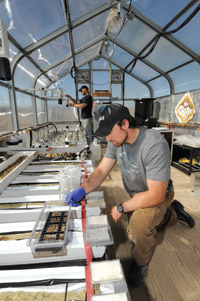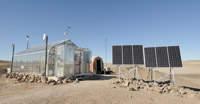
Before extended space explorations to the Moon and Mars can become a
reality, astronauts will need sustainable, reliable food sources from
green plants. Transporting enough food to feed space travellers for
long duration missions is too costly, in terms of mass and energy.
Before extended space explorations to the Moon and Mars can become a reality, astronauts will need sustainable, reliable food sources from green plants. Transporting enough food to feed space travellers for long duration missions is too costly, in terms of mass and energy. And it limits the amount of additional scientific cargo that can be transported on a space shuttle.
 |
|
| Matt Barnsey (front), who works with the Canadian Space Agency, joins fellow University of Guelph PhD candidate and research associate Thomas Graham in preparing the Enviro-Grow medium for field trials. (Photographer Janice Lang is with the Polar Continental Shelf Program of Natural Resources Canada.) Photo courtesy Janice Lang, july 2008 Advertisement
|
But Prof. Mike Dixon, a plant scientist and director of the Controlled Environment Systems Research Facility at the University of Guelph, is working to offer alternatives. Dixon is developing and testing new food-growing technologies by using a greenhouse in the Canadian Arctic to simulate harsh Martian climates. If his lettuce, radish, tomato and cucumber crops can be grown successfully within an Arctic environment, Dixon says the same technology could be applied to developing the first “farm” on Mars.
“Food is the limiting variable for long-term space exploration,” he says. “It limits our capacity to go away from Earth for a long time, as we simply can’t carry enough food.”
RESEARCH ASSESSES PLANT ENVIRONMENT INTERACTIONS
Dixon became involved with the Canadian Space Agency during the late 1980s, when he was approached to apply his controlled environment expertise towards space exploration. He had been developing technologies for assessing plant-environment interactions and realized that the very same technologies would be essential for determining how plants react to space environments.
Since then, Dixon has formed the Space and Advanced Life Support Agriculture (SALSA) program that investigates the contributions of plants to life support in space.
For his most recent work, Dixon is conducting greenhouse trials on innovative technologies for plant growth at the Arthur C. Clarke Mars Analog Greenhouse, which is located on Devon Island (the second largest of the Queen Elizabeth Islands in Nunavut) outside an ancient, 20-kilometre-wide meteorite impact crater.
The harsh, Arctic environment provides the researchers with the closest possible approximation to climate on Mars, with its barren, rocky landscape. Temperatures often dip as low as –50°C, and rarely exceed 5°C.
 |
|
| Devon Island’s barren, rocky terrain surrounding the greenhouse provides researchers with a convincing simulation of conditions on Mars. Photo courtesy Janice Lang, july 2008 |
CROP MANAGEMENT VIA REMOTE CONTROL
For 11 months each year, research is conducted via remote control, utilizing automated irrigation systems, solar panels, heating systems and a webcam network to track the progress of the plants and reaction of the crops to the Arctic environment.
Last summer, Dixon’s research assistant Thomas Graham travelled to the Devon Island greenhouse to conduct further tests with cucumber seeds on the Enviro-Grow System, a completely recyclable growth medium that the researchers have
been developing with SRI-Petrochemical in Ontario.
Because residual waste from growing the crops can’t be left behind in space, the Enviro-Grow System is re-usable for different crop cycles, and can also be combusted as fuel to power the greenhouse. The system is made primarily of polyurethane foam, features a built-in irrigation system and can also be custom-tailored to fit the dimensions of any greenhouse.
“Every atom of everything you take with you to space must be recyclable and contribute to life support requirements,” says Dixon. “Once you leave Earth, there’s no such thing as garbage – you can’t throw anything away, no matter what it is.”
On a wider scale, Dixon views space greenhouse research as the lynchpin for further space exploration, and sees the Canadian greenhouse industry as laying the groundwork for other countries. A number of collaborating institutions, such as the Universidad Autonoma de Barcelona in Spain, the University of Ghent in Belgium, the University of Napoli in Italy and the University of Bern in Switzerland have expressed a desire to acquire Canadian plant growth system technology for food production experiments destined for applications in space.
His goal is for each university to have the same plant growth systems so that simultaneous experiments can be carried out internationally. “This will foster more effective technology transfer and provide excellent opportunities for international student and technical personnel exchanges.”
DOWN-TO-EARTH APPLICATIONS WITH SPACE-AGE TECHNOLOGIES
Though the greenhouse technologies Dixon and his fellow researchers are developing have yet to be tested in space, he’s not worried. As far as Dixon is concerned, using the Moon and Mars as an inspiration to improve life on Earth is an enormous undertaking by itself, and an important economic stimulus.
“Even if we never get to Mars, just saying you’re going to go there and requiring yourself to master all the technical challenges is more than adequate in terms of spinning off technologies and commercialization opportunities,” says Dixon. “I’m going to go ahead and call this the Mars century, because it will surely take up the lion’s share of enterprise for this century.”
The infrastructure represented by the Controlled Environment Systems Research Facility (CESRF) was funded by the Canada Foundation for Innovation and the Ontario Innovation Trust with a significant portion of industry funding included.
Dixon’s research is funded by a variety of industry and government agencies including Flowers Canada Ontario, the Natural Sciences and Engineering Research Council, the Ontario Ministry of Agriculture, Food and Rural Affairs, and the Canadian Space Agency. The Ontario Centres of Excellence, a non-profit group under the Ontario Ministry of Research and Innovation, provides extensive business development assistance, networking with industry partners and leverage funding in collaboration with industry partners.
Dixon also collaborates with companies such as Beverly Greenhouses that performs commercial-scale field trials using technologies his group develops. ■
Joey Sabljic is a student writer with the SPARK (Students Promoting Awareness of Research Knowledge) program at the University of Guelph.
Print this page